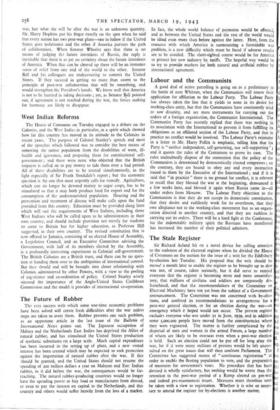The Future of Rubber
The very success with which some war-time economic problems have been solved will create fresh difficulties after the war unless steps are taken to avert them. Rubber presents one such problem, as an opportune article in the last issue of the Bulletin of International News points out. The Japanese occupation of Malaya and the Netherlands East Indies has deprived the Allies of natural rubber, and has stimulated the United States production of synthetic substitutes on a large scale. Much capital expenditure has been incurred in the setting up of plant, and a new vested interest has been created which may be expected to seek protection against the importation of natural rubber after the war. If this should be granted, and the United States should not resume the spending of 200 million dollars a year on Malayan and East Indian rubber, as it did before the war, the consequences would be far- reaching. The natural rubber-producing countries would no longer have the spending power to buy food or manufactures from abroad, or even to pay the interest on capital to the Netherlands, and this country and others would suffer heavily from the loss of a market.
In fact, the whole world balance of payments would be affected, and as between the United States and the rest of the world would be tilted even more than before against the latter. Here, from the resource with which America is surmounting a formidable war problem, is a new difficulty which must be faced if adverse results are to be avoided. The short-siglited course would be for America to protect her new industry by tariffs. The hopeful way would be to try to provide markets for both natural and artificial rubber by international agreement.


























 Previous page
Previous page